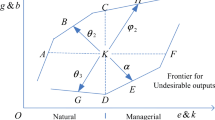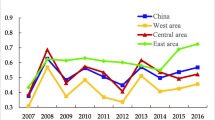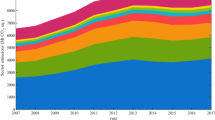Abstract
The nonconventional by-production approach with respect to the freely disposable inputs but without the weakly disposable and null-joint outputs has been proposed to describe the pollution generating technologies since 2012. To amend the contradictory trade-offs among inputs, intended and unintended outputs, which generate in the previous conventional pollution-generating technologies, the new by-production approach decomposes the general pollution generating technology as classical intended production technology and nature’s residual-generation mechanism. In this paper, some production and environmental efficiency indexes will be extended and firstly applied in the study of regional technical efficiency level with considering the energy utilization and air pollutants emission in China. Based on our calculating results, there exists the obvious variation in the regional technical efficiency level with the regional geographic separation. Eastcoast area ranks the highest in production efficiency measurement, and the West has the lowest levels in both production and environmental efficiency. Through conducting some reason discussions, our new efficiency results based on the by-production approach are consistent with the fact of Chinas unbalanced regional development pattern and also reveal the ineffectiveness of current environmental policy implementations.





Similar content being viewed by others
Notes
The standard single-equation representation of weak-disposability approach shows the non-positive trade-off between input and undesirable output when desirable output held fixed and the non-negative trade-off between desirable output and undesirable output with fixed input. These two trade-offs can be argued to be counter to the emission generation fact (Murty et al. 2012).
Here, the authors only consider the undesirable outputs (emissions) from the production process (e.g. tons of \({\rm SO}_{2}\) and \({\rm CO}_2\)) and not the externality they might cause.
Murty (2015) provides a generalisation of this where emissions from a firm may affect its own desirable production in a beneficial or detrimental manner.
These two efficiency measures indexes have been widely used in study WD approach. In this paper, they will be modified and employed to measure technical efficiency under the BP approach.
The output-oriented version index takes up all slack in output spaces and leaves the slack in inputs spaces.
We denote \(y\oslash \theta =\langle y_{1}/\theta _{1},\ldots y_{M}/\theta _{M}\rangle\) and \(b\otimes \gamma =\langle b_{1}\gamma _{1},\ldots b_{K}\gamma _{K}\rangle\).
Due to lack of some data on regions such Tibet, Hongkong, Macau and Taiwan, we only consider 30 provincial level regions, including 22 provinces, 4 municipalities and 4 autonomous regions.
CNY is an abbreviation for Chinese currency “Yuan”.
The PIM could be straightforward as
$$\begin{aligned} {K_{i,t}} = {K_{i,t - 1}}\left( {1 - {\delta _i}} \right) + {I_{i,t}}. \end{aligned}$$where, i and t represent the \(i{\rm th}\) province and \(t{\rm th}\) year, respectively. K denotes the capital stock. \(\delta\) and I denote the depreciation rate and capital asset investment of year, respectively. The initial capital stock (based year: 2000) and depreciation rates are derived from Zhang et al. (2004). The annual capital asset investment is obtained from the “China Statistical Yearbook”.
The definition of \({\rm SO}_2\) variable can be found in the National Bureau of Statistics of China. Net \({\rm SO}_2\) emission refers to volume of sulphur dioxide emission from burning fossil-fuel during production in the premises of enterprises in each region for a given period of time.
The reference approach to calculate the \({\rm CO}_2\) emission is designed as
$$\begin{aligned} {{\rm CO}_2}_{\rm emission} = \sum \limits _i {\left( {{\rm AC}_i \cdot {\rm CF}_i \cdot {\rm CC}_i} \right) } \cdot {\rm COF} \cdot 44/12. \end{aligned}$$Here, \({\rm AC}_i\) represents the apparent energy consumption for fossil fuel i . \({\rm CF}_i\) is the conversion factor for fuel i to energy. \({\rm CC}_i\) is the carbon content for i fuel. COF is the carbon oxidation factor, usually the value is 1. And 44 / 12 equals to molecular weight ratio of \({\rm CO}_2\) to C. The data on energy consumption are taken from the “China Energy Statistical Yearbook”.
Due to the only one desirable output is chosen (\(M=1\)) in this paper, the results of decomposition of FGL production efficiency \(D_{\rm FGL(1)}\) for each region in every year are exactly same with \(D_{\rm HYP(1)}\) in HYP. Hence, the differences between integrated efficiency scores could be mainly attributed to calculation of environmental efficiency scores under these two methods. If \(M\ge 2\), the programming for production efficiency calculation should be designed to take the coordinate-wise distances from each desirable output observation to the corresponding possibility frontier. Hence, \(D_{\rm HYP(1)}=D_{\rm FGL(1)}\) is the occasional case with \(M=1\).
Source from: China National Energy Administration.
Statistical data come from the report of “Coal use contribution to China’s air pollution” by China’s coal consumption control scheme and policy research, 2014.
Zeng (2011) uses the input-oriental variable return to scale (VRS) model based on the DEA efficiency measurement of Charnes et al. (1978) to measure China’s regional total technical efficiency with bad output consideration. Then, it also employs Tobit regression and finds the technology innovation has a negative effect on regional technology efficiency.
Data from: statistical departments in Ministry of Environmental Protection and Ministry of Housing and Urban-rural Development, P. R. China.
According to the latest statement from Ministry of Environmental Protection of Peoples’ Republic of China, the new discharge rate will increase to 1.20 CNY/kg for main air pollutants.
References
Bian Y, Yang F (2010) Resource and environment efficiency analysis of provinces in China: a DEA approach based on Shannon’s entropy. Energy Policy 38(4):1909–1917
Cao H, Fujii H, Managi S (2015) A productivity analysis considering environmental pollution and diseases in China. J Econ Struct 4(1):1–19
Caves DW, Christensen LR, Diewert WE (1982) The economic theory of index numbers and the measurement of input, output, and productivity. Econometrica 50(6):1393–1414
Charnes A, Cooper WW, Rhodes E (1978) Measuring the efficiency of decision making units. Eur J Oper Res 2(6):429–444
Chung YH, Färe R, Grosskopf S (1997) Productivity and undesirable outputs: a directional distance function approach. J Environ Manag 51(3):229–240
Coggins JS, Swinton JR (1996) The price of pollution: a dual approach to valuing \({\rm SO}_2\) allowances. J Environ Econ Manag 30(1):58–72
Färe R, Grosskopf S (2003) New directions: efficiency and productivity. Kluwer Academic Publishers, Boston
Färe R, Grosskopf S, Hernandez-Sancho F (2004) Environmental performance: an index number approach. Resour Energy Econ 26(4):343–352
Färe R, Grosskopf S, Lovell CK, Pasurka C (1989) Multilateral productivity comparisons when some outputs are undesirable: a nonparametric approach. Rev Econ Stat 71(1):90–98
Färe R, Grosskopf S, Lovell CK, Yaisawarng S (1993) Derivation of shadow prices for undesirable outputs: a distance function approach. Rev Econ Stat 75(2):374–380
Färe R, Grosskopf S, Noh D-W, Weber W (2005) Characteristics of a polluting technology: theory and practice. J Econom 126(2):469–492
Färe R, Grosskopf S, Tyteca D (1996) An activity analysis model of the environmental performance of firms application to fossil-fuel-fired electric utilities. Ecol Econ 18(2):161–175
Fisher-Vanden K, Jefferson GH, Ma J, Xu J (2006) Technology development and energy productivity in China. Energy Econ 28(5):690–705
Fleisher BM, Chen J (1997) The coast-noncoast income gap, productivity, and regional economic policy in China. J Comp Econ 25(2):220–236
Fujii H, Cao J, Managi S (2015) Decomposition of productivity considering multi-environmental pollutants in Chinese industrial sector. Rev Dev Econ 19(1):75–84
Fujii H, Managi S, Kaneko S (2013) Decomposition analysis of air pollution abatement in China: empirical study for ten industrial sectors from 1998 to 2009. J Clean Prod 59:22–31
Grosskopf S (1996) Statistical inference and nonparametric efficiency: a selective survey. J Product Anal 7(2–3):161–176
Harbaugh WT, Levinson A, Wilson DM (2002) Reexamining the empirical evidence for an environmental kuznets curve. Rev Econ Stat 84(3):541–551
Hausman JA (1978) Specification tests in econometrics. Econom J Econom Soc 46(6):1251–1271
Hong Y, Zhang H, Zhu Y (1993) Sulfur isotopic characteristics of coal in China and sulfur isotopic fractionation during coal-burning process. Chin J Geochem 12(1):51–59
Hu J-L, Wang S-C (2006) Total-factor energy efficiency of regions in China. Energy Policy 34(17):3206–3217
IEA (2013) \({\rm CO}_2\) emissions from fuel combustion 2013. IEA, Paris. doi:10.1787/co2_fuel-2013-en
IPCC (2006) IPCC guidelines for national greenhouse gas inventories, prepared by the national greenhouse gas inventories programme. Institute for Global Environmental Strategies (IGES), Tokyo, Japan, 2007
Kanbur R, Zhang X (1999) Which regional inequality? The evolution of rural-urban and inland-coastal inequality in China from 1983 to 1995. J Comp Econ 27(4):686–701
Kanbur R, Zhang X (2005) Fifty years of regional inequality in China: a journey through central planning, reform, and openness. Rev Dev Econ 9(1):87–106
Liao H, Liu X, Wang C (2012) Knowledge spillovers, absorptive capacity and total factor productivity in China’s manufacturing firms. Int Rev Appl Econ 26(4):533–547
Liu J, Diamond J (2005) China’s environment in a globalizing world. Nature 435(7046):1179–1186
Lu W-M, Lo S-F (2007) A closer look at the economic-environmental disparities for regional development in China. Eur J Oper Res 183(2):882–894
Murty MN, Kumar S (2002) Measuring the cost of environmentally sustainable industrial development in India: a distance function approach. Environ Dev Econ 7(3):467–486
Murty MN, Kumar S (2003) Win-win opportunities and environmental regulation: testing of porter hypothesis for Indian manufacturing industries. J Environ Manag 67(2):139–144
Murty S (2015) On the properties of an emission-generating technology and its parametric representation. Econ Theory 60(2):243–282
Murty S, Robert Russell R, Levkoff SB (2012) On modeling pollution-generating technologies. J Environ Econ Manag 64(1):117–135
Nakano M, Managi S (2012) Waste generations and efficiency measures in Japan. Environ Econ Policy Stud 14(4):327–339
OECD (2006) Environmental compliance and enforcement in China: an assessment of current practices and ways forward. OECD, Paris
Panayotou T (1997) Demystifying the environmental Kuznets curve: turning a black box into a policy tool. Environ Dev Econ 2(04):465–484
Rezek JP, Rogers K (2008) Decomposing the \({\rm Co}_2\) income tradeoff: an output distance function approach. Environ Dev Econ 13(04):457–473
Stern DI, Common MS, Barbier EB (1996) Economic growth and environmental degradation: the environmental Kuznets curve and sustainable development. World Dev 24(7):1151–1160
Tsurumi T, Managi S (2010) Decomposition of the environmental Kuznets curve: scale, technique, and composition effects. Environ Econ Policy Stud 11(1–4):19–36
Tyteca D (1997) Linear programming models for the measurement of environmental performance of firms-concepts and empirical results. J Product Anal 8(2):183–197
Wang K, Yu S, Zhang W (2013) China’ regional energy and environmental efficiency: a DEA window analysis based dynamic evaluation. Math Comput Model 58(5):1117–1127
Wang L, Li R (2001) Typical kinds of coal in China and some special coals with their fly ash difficult to precipitate by ESP. In: Presented at the 8th International Conference on Electrostatic Precipitation, 14–17 May 2001
Wang Q, Zhou P, Zhou D (2012) Efficiency measurement with carbon dioxide emissions: the case of China. Appl Energy 90(1):161–166
Xiao H-Y, Liu C-Q (2011) The elemental and isotopic composition of sulfur and nitrogen in Chinese coals. Org Geochem 42(1):84–93
Zeng X (2011) Environmental efficiency and its determinants across Chinsese regions (in Chinese). Econ Theory Bus Manag 10:103–110
Zhang J, Wu G, Zhang J (2004) The estimation of China’s provincial capital stock: 1952–2000. Econ Res J 10:35–44 (in Chinese)
Zhang S, He H, Cao J (2001) Environmental policy innovation: discussion on implementing environmental tax in China. Acta Sci Nat Univ Pekin 37(4):550–556
Acknowledgments
The author is indebted to Dr. Sushama Murty and an anonymous referee; participants at the The 5th Congress of East Asian Association of Environmental and Resource Economics (EAAERE) 2015 in Taipei helpful suggestions on earlier versions of the paper. All remaining errors are the author’s responsibility.
Author information
Authors and Affiliations
Corresponding author
Ethics declarations
Conflict of interest
The authors declare that they have no conflict of interest.
This study does not contain any studies with human participants or animals performed by any of the authors.
Informed consent
Informed consent was obtained from all individual participants included in the study.
About this article
Cite this article
Zhao, Z. Measurement of production efficiency and environmental efficiency in China’s province-level: a by-production approach. Environ Econ Policy Stud 19, 735–759 (2017). https://doi.org/10.1007/s10018-016-0172-3
Received:
Accepted:
Published:
Issue Date:
DOI: https://doi.org/10.1007/s10018-016-0172-3
Keywords
- By-production
- Date envelopment analysis
- Production efficiency
- Environmental efficiency
- Disparity regional development




